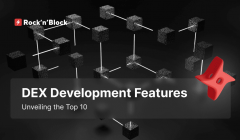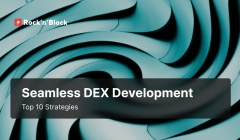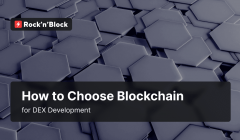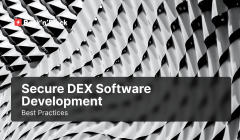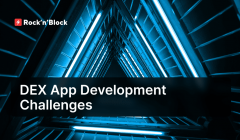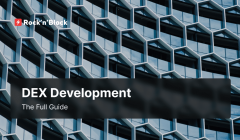Full Guide on Crypto Exchange Development Cost in 2024
03 May 2024Importance of Understanding a Crypto Exchange Development Cost
The allure of crypto exchanges remains undeniable. These platforms serve as the gateway for traders and investors to engage in the trading of various cryptocurrencies. However, amidst the excitement of entering this burgeoning market, one crucial aspect often overlooked is understanding the crypto exchange development cost.
The crypto exchange development cost encompasses the financial investment required to build and launch a cryptocurrency exchange platform. This investment covers a wide array of expenses, including software development, security measures, regulatory compliance, and infrastructure setup. Ignoring or underestimating these costs can have profound implications for aspiring exchange owners.
First and foremost, comprehending the intricacies of crypto exchange development cost is essential for budgeting purposes. Like any other business venture, launching a cryptocurrency exchange requires meticulous financial planning. By understanding the cost breakdown, entrepreneurs can allocate resources effectively, avoiding budget overruns and financial strain during the development process.
Moreover, a thorough understanding of crypto exchange development cost enables stakeholders to make informed decisions regarding the development approach. Entrepreneurs must weigh the pros and cons of building a custom exchange from scratch versus utilizing white-label or turnkey solutions. Each approach carries its own set of costs and considerations, ranging from development time to scalability and customization options.
In conclusion, grasping the nuances of crypto exchange development cost is indispensable for anyone embarking on the journey of building and operating a cryptocurrency exchange. It empowers entrepreneurs to make informed decisions, allocate resources judiciously, prioritize security and compliance, and ultimately increase the likelihood of success in this dynamic and competitive industry.
How Much Does It Cost to Start a Crypto Exchange?
The initial cost of starting a crypto exchange can vary significantly based on several factors. Generally, the cost of building a basic crypto exchange platform starts from $40,000. However, for more advanced features and customization, the cost can escalate to $1 million or more.
Now we will delve deeper into key cost-affecting factors to provide a more comprehensive evaluation of the expenses associated with starting a crypto exchange.
Type of Crypto Exchange Development
Among the first factors to evaluate is the type of crypto exchange development.
Decentralized Crypto Exchange Development Cost
Decentralized exchanges (DEX) operate on blockchain technology and eliminate the need for intermediaries by enabling peer-to-peer trading. They prioritize security, privacy, and censorship resistance, allowing users to retain control over their funds. On average, a basic cost for DEX development starts from $40,000, while more advanced features and scalability solutions may increase the cost up to $500,000 or more.
There are different types of decentralized exchanges:
-
Perpetual DEX: Perpetual DEX development introduces perpetual swaps, a game-changer that eliminates the limitations of expiration dates. This breakthrough concept frees traders from time constraints, allowing them to ride market trends without pressure. Development costs for a perpetual DEX start from $50,000 due to the complexity of building and auditing smart contracts, ensuring scalability, and providing a seamless user experience.
-
Concentrated Liquidity: Concentrated liquidity DEX development offers efficient trading with lower slippage by concentrating liquidity around specific price ranges. Implementing concentrated liquidity features involves designing and deploying sophisticated algorithms, optimizing liquidity pools, and ensuring continuous liquidity provision. Development costs for exchanges with concentrated liquidity start from $40,000, reflecting the expertise and resources required to build and maintain these systems.
Platform Selection
This decision hinges on whether to embark on the journey of building a crypto exchange from scratch, opt for existing solutions, or consider forking decentralized exchanges. Each approach presents its own set of advantages, challenges, and associated costs, necessitating a thorough evaluation to determine the most suitable path forward.
1. Building from Scratch
Building a crypto exchange from scratch involves developing the platform's infrastructure, features, and functionalities entirely from the ground up. Entrepreneurs have complete control over every aspect of the exchange, allowing for tailored solutions to meet specific business requirements and user preferences. While this approach offers unparalleled flexibility and customization options, it also requires a substantial investment of time, resources, and technical expertise. The process for a custom crypto exchange development can be lengthy, typically spanning several months to a year or more, depending on the complexity of features and functionalities.
Building a crypto exchange from scratch entails significant upfront costs, with initial investments starting from $100,000, depending on the scope and scale of the project. Maintenance costs for a custom exchange include server hosting, software updates, security enhancements, and technical support, amounting to thousands of dollars per month.
3. Forking Decentralized Exchanges
Another option gaining traction in the cryptocurrency community is forking existing DEXs. Forking involves copying the codebase of a DEX and making modifications to create a new exchange with unique features or improvements. This approach combines the benefits of decentralization with the flexibility to customize and innovate.
Forking DEXs typically involves lower development costs compared to building from scratch, as the core infrastructure is already in place. Initial investments may start from $25,000, depending on the extent of modifications and customizations. While forking DEXes requires less technical expertise compared to building from scratch, developers still need proficiency in blockchain technology, smart contract development, and decentralized protocols.
Explore our series of guides on forking top decentralized exchanges:
Create a DEX like Uniswap: Overview and Forking Guidelines
Create a DEX like PancakeSwap: A Step-by-Step Guide
PancakeSwap V4 Update Overview For Those Who Plan to Fork
Development Team
In the realm of crypto exchange development, the choice of development team has a significant impact on project outcomes. However, not all development teams are equal, as different companies offer developers with varying levels of expertise and experience. While top-tier developers command higher rates, choosing the most expensive option isn't always the wisest choice. Instead, business owners should consider several factors to ensure the best fit for their project.
1. Expertise Levels: Crypto exchange development teams encompass professionals of varying expertise levels, from junior developers to seasoned specialists, each contributing unique insights, skills and rates.
2. Experience: Seasoned developers bring valuable experience and problem-solving abilities, mitigating risks and ensuring project success.
3. Rates: While top-tier developers may come with higher rates, it's essential to balance cost with quality and efficiency to achieve optimal outcomes.
4. Collaboration and Communication: Effective communication and collaboration within the development team are crucial for maintaining project alignment and momentum.
Technology Stack
In crypto exchange development, the technology stack serves as the backbone of the platform, encompassing the programming languages, frameworks, databases, and infrastructure components used to build and operate the exchange. Choosing the right technology stack is crucial for ensuring optimal performance, scalability, security, and cost-effectiveness. However, the selection process involves navigating a myriad of options, each with its own advantages, challenges, and associated costs. Let's explore the various components of the technology stack.
1. Programming Languages
Programming languages form the foundation of the technology stack, dictating how the exchange platform is built and functions. Common languages used in crypto exchange development include:
- JavaScript (Node.js) for backend development.
- TypeScript for frontend development.
- Solidity for smart contract development on blockchain platforms like Ethereum.
2. Frameworks
Frameworks provide developers with pre-built libraries, tools, and functionalities to expedite the development process and ensure code reliability. Popular frameworks for crypto exchange development include:
- Express.js for backend development.
- React.js for frontend development.
- Truffle for Ethereum smart contract development.
3. Databases
Databases are essential for storing and managing user data, transaction records, and other critical information. Common database options for crypto exchanges include:
- PostgreSQL for relational databases.
- MongoDB for NoSQL databases.
4. APIs
In the world of crypto exchange development, Application Programming Interfaces (APIs) are indispensable tools for integrating services, customizing functionality, and streamlining development. APIs serve as the glue that connects different software components, enabling seamless interaction with external services and applications. APIs is also affecting the crypto exchange development cost. Prices for integrating APIs typically start from $5,000.
Every technology stack comes with unique advantages and drawbacks for crypto project development. Rates of experts working with each stack vary significantly. It's crucial to evaluate the stack for your project and find developers aligned with your vision, goals, and cost expectations. Fortunately, many robust crypto exchange development companies offer consulting services. They're open to discussing your project, guiding you to select the most appropriate variant aligned with your goals, ensuring a successful development journey.
User Experience and Interface
In crypto exchange development, optimizing user experience (UX) and interface (UI) design is critical for attracting and retaining users. Investing in a seamless and intuitive user interface (UI) not only enhances user satisfaction but also influences the overall success and competitiveness of the crypto exchange platform. Here's how UX/UI design affects crypto exchange development costs:
1. Design Complexity
The complexity of UX/UI design directly affects crypto exchange development costs. A sophisticated and visually appealing design requires more time, effort, and expertise to implement compared to a simple design. Complex designs with intricate features, animations, and interactive elements may incur higher design and development costs due to the additional time and resources required for implementation.
2. Customization Requirements
Tailoring the exchange platform's UI to meet specific branding or user experience requirements can increase crypto exchange development costs. Customizing colors, fonts, layouts, and interactive elements requires additional design and development work, impacting overall project expenses. However, investing in customization can differentiate the exchange from competitors and enhance brand identity, ultimately contributing to long-term success.
3. Responsive Design
Ensuring that the crypto exchange platform is accessible and functional across various devices and screen sizes is essential for providing a consistent user experience. Implementing responsive design principles requires additional efforts to adapt the UI to different viewport sizes and resolutions. While responsive design adds to development costs, it's necessary for reaching a wider audience and maximizing user engagement.
Usually, the cost of UX/UI design for a crypto exchange depends on the number of hours dedicated to the project. The final cost is calculated by multiplying the hours spent on design by the company's designer hourly rate. This method allows flexibility in budgeting and ensures transparency in pricing, as clients pay for the actual time and effort invested in crafting a tailored and user-centric design for their exchange platform.
Integrating Additional Features
As crypto exchanges strive to differentiate themselves in a crowded market, the integration of additional features beyond core trading functionalities has become increasingly important. However, each feature comes with its own development considerations, which can affect the overall crypto exchange development cost. Let's explore how the integration of specific features impacts development costs:
1. Complexity of Features
Features such as derivatives trading, yield farming, automated market makers (AMMs), referral and royalty rewards programs, are inherently complex and require advanced technical expertise to implement effectively. The development complexity of these features often translates to higher development costs, as crypto exchange developers need more time and resources to ensure proper functionality and integration.
2. Integration with External Services
Features like real-time market data and TradingView integration require seamless integration with external services and APIs. The complexity of integrating with third-party services, as well as any associated licensing fees, can contribute to higher crypto exchange development costs. Additionally, ensuring compatibility and reliability with external services may require extensive testing and optimization, further adding to development expenses.
3. User Experience Enhancements
Features aimed at improving user experience, such as advanced fee calculator, order book visualisation, and charting tools, are essential for attracting and retaining users. However, implementing these features to meet high standards of usability and functionality requires investment in UX/UI design, frontend development, and user testing, which can increase development costs.
4. Regulatory Compliance and Security
Features related to regulatory compliance, security, and risk management, such as slippage mitigation, gas optimization, and impermanent loss protection, are important for ensuring the trust and safety of users. Implementing robust security measures, compliance checks, and risk management protocols adds complexity to development and may require additional resources, increasing overall development costs.
5. Customization and Scalability
Features that offer customization options, such as a customizable dashboard, diverse order types, and dynamic fee tiers, provide flexibility for users and enhance the competitiveness of the exchange. However, implementing customizable features requires careful consideration of scalability, performance, and maintenance implications, which may impact crypto exchange development cost, particularly in terms of backend infrastructure and database design.
Check out our guide to learn more about the wide range of features to implement: List of 30 Features for Decentralized Exchange Development.
While integrating additional features can enhance the value proposition of a crypto exchange, it's essential to consider the associated development costs and resource requirements. By carefully evaluating the complexity, integration dependencies, user experience implications, and scalability requirements of each feature, businesses can make informed decisions that balance functionality with cost-effectiveness, ultimately driving the success and competitiveness of their platform.
Security and Quality Assurance
Security measures and quality assurance (QA) are paramount in crypto exchange development to safeguard user assets, data, and trust. However, implementing robust security protocols and ensuring high-quality standards come with associated costs that must be carefully managed. Let's explore how security measures and QA processes impact the overall crypto exchange development cost:
1. Security Measures
Implementing comprehensive security measures, such as encryption, two-factor authentication (2FA), and cold storage solutions, is essential for protecting user funds and data from cyber threats. Additionally, conducting regular security audits and penetration testing helps identify and mitigate vulnerabilities. However, these security measures require specialized expertise and resources, contributing to higher crypto exchange development costs.
2. Regulatory Compliance
Ensuring compliance with regulatory requirements, such as Know Your Customer (KYC) and Anti-Money Laundering (AML) regulations, is critical for operating a legitimate and compliant crypto exchange. Implementing compliance features, such as identity verification, transaction monitoring, and reporting mechanisms, requires thorough documentation, integration with third-party services, and ongoing maintenance, which can increase crypto exchange development costs.
3. Quality Assurance (QA)
Quality assurance encompasses various processes, including functional testing, performance testing, security testing, and user acceptance testing (UAT), to ensure the reliability, usability, and performance of the exchange platform. Investing in comprehensive QA processes helps identify and rectify issues early in the development lifecycle, reducing the risk of costly errors and system failures post-launch.
4. Scalability and Reliability
Building a scalable and reliable exchange platform requires careful planning, architecture design, and infrastructure setup to accommodate growing user demand and market fluctuations. Implementing redundant systems, load balancing mechanisms, and disaster recovery protocols enhances the platform's resilience but may entail additional development costs, particularly for cloud hosting services and infrastructure optimization.
Ongoing Maintenance and Support
Ongoing maintenance and support are critical components of crypto exchange development, ensuring the platform remains secure, reliable, and compliant over time. However, the costs associated with these activities can vary depending on factors such as the development company's rates, the complexity of the platform, and the level of ongoing support required. Let's explore how these factors influence the overall cost of ongoing maintenance and support:
1. Development Company Rates
The rates charged by the chosen crypto exchange development company for ongoing maintenance and support services significantly impact the overall cost. Development companies may offer different pricing models, including hourly rates, retainer agreements, or fixed-price contracts.
2. Complexity of the Platform
The complexity of the exchange platform influences the amount of ongoing maintenance and support required. A platform with advanced features, complex trading functionalities, and integration with external services may require more extensive monitoring, updates, and bug fixes compared to a simpler platform.
3. Level of Ongoing Support Required
The level of ongoing support required by exchange operators varies based on factors such as user base size, trading volume, and regulatory compliance obligations. Exchange operators may opt for different levels of support, ranging from basic maintenance and bug fixes to proactive monitoring, 24/7 support, and dedicated account management. The level of ongoing support chosen by exchange operators influences the scope of services provided by the development company and, consequently, the associated crypto exchange development costs.
Conclusion
Embarking on crypto exchange development requires a comprehensive understanding of the various factors that influence costs throughout the development lifecycle. From initial planning and design to ongoing maintenance and support, each stage presents unique considerations that can impact the overall cost and success of the project.
Collaborating with experienced crypto exchange development company, like Rock'n'Block, who offer expertise in blockchain technology and a deep understanding of the crypto industry, can streamline the development process and ensure the delivery of a robust and competitive exchange platform.
At Rock’n’Block, we understand that every project is unique, and we take the time to discuss every detail with our clients to ensure that we deliver a perfect solution that aligns with their vision and price expectations. Our dedicated team of experts brings a wealth of experience and industry knowledge, guiding you through each stage of development and providing tailored solutions to meet your specific needs.
Whether you're looking to build a crypto exchange, we work closely with you to understand your requirements, address any concerns, and optimize costs without compromising on quality. With Rock'n'Block as your trusted partner in crypto exchange development, you can rest assured that your project is in capable hands, and together, we will navigate the complexities of crypto exchange development to bring your vision to life!
We ❤️ Development
Follow us on social media to receive the hottest blockchain development updates
Twitter ⚡️Telegram⚡️LinkedIn⚡️Facebook

